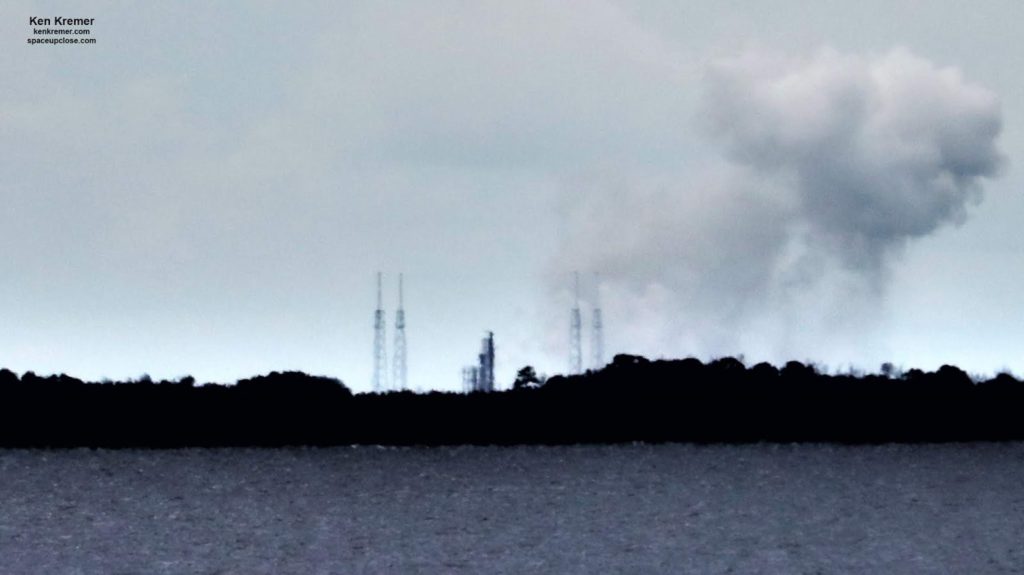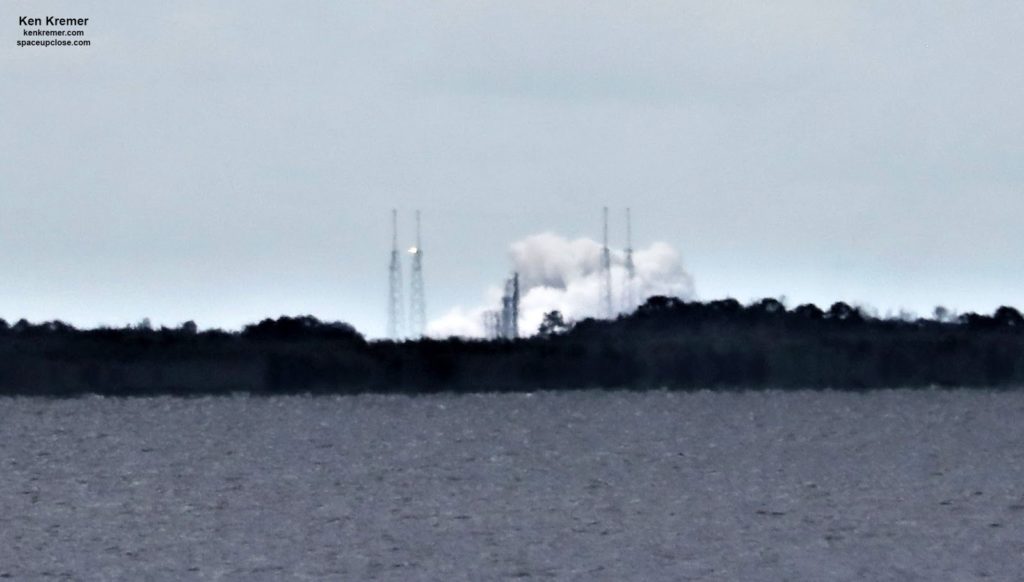Unfortunately the weekend weather outlook is rather unfavorable – so plan for extra days in
case of a scrub.
The brief hold down static hot fire test involving ignition of all nine Merlin 1D Falcon 9 first stage engines was carried out by SpaceX engineers at 8 p.m. EDT (0000 GMT Aug. 1) on pad 40 at Cape Canaveral Air Force Station, Fl., using a recycled twice used booster of the
upgraded Block 5 version of their workhorse Falcon 9.
Check out my exclusive Space UpClose eyewitness photos captured about 13 miles away late
Wednesday evening, July 31, along the Indian River lagoon in Titusville, FL.
SpaceX announced the completion of the static fire test nearly 2 hours later which paves the path towards the targeted launch date of Aug. 3.
However in contrast to normal practices confirming a good test result, they further stated that engineers were still assessing all the data.
“Static fire test of Falcon 9 complete and team is assessing data—targeting August 3 for launch of AMOS-17 from Pad 40 in Florida,” SpaceX tweeted.
The dinnertime Falcon 9 liftoff is targeted to take place 6:52 p.m. EDT (2252 GMT) Saturday, Aug. 3 from Space Launch Complex 40 at Cape Canaveral Air Force Station in Florida – at the beginning of the launch window.
The launch window extends from 6:52 p.m. EDT (2252 GMT) and extends almost 90 minutes until 8:20 p.m. EDT (0020 GMT).
The Boeing-built AMOS-17 satellite is owned and operated by the Israeli Tel
Aviv-based telecom company Spacecom.
Fortunately the static fire test appeared to go without incident in contrast to the prior AMOS-6 satellite for Spacecom which was destroyed in a catastrophic explosion just minutes before engine ignition during its static fire test when the payload was bolted on top of the Falcon 9.
Since that devastating explosion in Sept 2016, SpaceX has avoided placing commercial payloads on top of the Falcon 9 during static fire test campaigns.
 |
| Credit: Ken Kremer/kenkremer.com/spaceupclose.com |
This particular Falcon 9 first stage previously launched twice on the Telstar-19 VANTAGE and Es’hail-2 missions in 2018 and has once again been refurbished for reuse.
But this launch will be its last launch says Spacecom.
For its third and final flight this Falcon 9 first stage booster will fly with no landing legs and
no grid fins.
Spacecom needs all the lifting power of the Falcon 9 rocket to achieve its intended orbit for the
heavy 6.5 ton AMOS-17 and maximize its lifetime in orbit.
AMOS-17 has a fully fueled weight of 6.5 metric tons (14,330 pounds).
 |
|
SpaceX Falcon 9 rocket is on its way to the
Launch Complex-40 Hangar, where it will be mated with the encapsulated satellite for the AMOS-17 launch scheduled for Aug. 3, 2019. Credit: Spacecom |
Once in geostationary orbit AMOS-17 will be operating at 17 degrees east.
 |
|
AMOS-17 geocomsat ready for encapsulation in
SpaceX Falcon 9 payload fairing. Credit: Spacecom/SpaceX |
The first two stages of the Falcon 9 were rolled out and raised Wednesday morning and finally raised vertical by 11 a.m. at pad 40 at Cape Canaveral Air Force Station in Florida.
Threatening weather may have delayed the rollout and test throughout the day whoch was
completed just in time to maintain the chance of a Saturday evening liftoff.
The hold down static fire test is routinely carried by SpaceX to ensure all is ready with the
rocket.
During the engine test all nine Merlin 1D first stage engines are briefly ignited for several seconds.
During Wednesday’s hold down static fire test, the rocket’s first and second stages are fueled with liquid oxygen and RP-1 propellants just like an actual launch, and a simulated countdown was
carried out to the point of a brief engine ignition lasting around 3 seconds or so.
With the pad in waning daylight near sunset and dark clouds overhead I was able to observe
a large vapor cloud of exhaust emitted from the Falcon 9 first stage in the moments after ignition.
I did not hear the rockets engines ruble several seconds later as the vapor cloud very slowly dissipated and lingered longer than normal – apparently due to by them calm winds.
The hold down engine test with the erected Falcon 9 rocket involved the ignition of all nine
Merlin 1D first stage engines generating some 1.7 million pounds of thrust at pad 40 while the two stage rocket was restrained on the pad – minus the AMOS-17 payload and nose cone.
The launch weather outlook is poor this weekend.
Meteorologists with the U.S. Air Force 45th Space Wing predict only a 30% chance of acceptable GO conditions.
In case of a scrub, the backup launch opportunity on Sunday only improves marginally to 40% GO.
Stay tuned.
Watch for Ken’s continuing onsite coverage of NASA, SpaceX, ULA, Boeing, Lockheed Martin,
Northrop Grumman and more space and mission reports direct from the Kennedy Space Center, Cape Canaveral Air Force Station, Florida and Wallops Flight Facility, Virginia.
Stay tuned here for Ken’s continuing Earth and Planetary science and human spaceflight news: www.kenkremer.com –www.spaceupclose.com – twitter @ken_kremer – email: ken at kenkremer.com
Dr. Kremer is a research scientist and journalist based in the KSC area, active in outreach and interviewed regularly on TV and radio about space topics.
Ken’s photos are for sale and he is available for lectures and outreach events
Ken’s upcoming outreach events:
Aug 1/2: Quality Inn Kennedy Space Center, Titusville, FL, evenings. Learn more
about the upcoming/recent SpaceX AMOS-17, SpaceX Falcon 9/CRS-18 launch to ISS, NASA Orion Ascent-2 Abort test Falcon Heavy, NASA 2024 Moon landing goal, SpaceX Starlink-1, SpaceX Demo-1 launch/test failure, SpaceX Beresheet launch, NASA missions, ULA Atlas & Delta launches, Northrop Grumman Antares, SpySats and more
Ken will display his photos for sale





